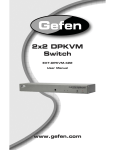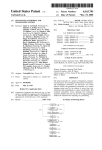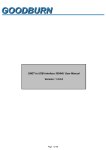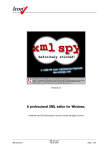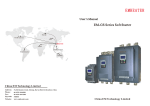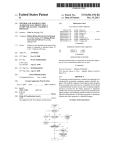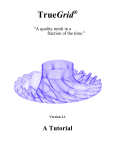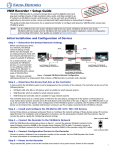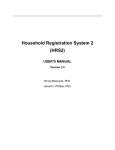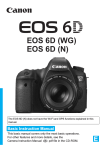Download Auto channel assignment for live productions
Transcript
US008432496B2 (12) United States Patent (10) Patent N0.2 Benson (45) Date of Patent: (54) AUTO CHANNEL ASSIGNMENT FOR LIVE PRODUCTIONS (75) Inventor: US 8,432,496 B2 Apr. 30, 2013 345/723, 716e717, 719, 722, 724e726, 730e732; 707/503, 101e102, 104, 500.1; H04N 5/222 See application ?le for complete search history. John R. Benson, Jacksonville, FL (US) _ (56) References Cited (73) Assignee: Thomson Licensing, BoulogneBinancoun (FR) U.S. PATENT DOCUMENTS 5,311,423 A ( * ) Notice: U-S-CSubject-154(1)) to any by disclaimer, 250 days~ - the term ofthis (21) Appl. No.: (22) PCT Filed: 2007/0033612 , , A1 >l<i 12/736,448 PCT No.: § 371 (0)0), (2), (4) Date: (87) 2/2007 gogget Lerman 0 H18 etetal. a1t~ ea1‘a.‘~~~~~~~~~~~~~~~~ ‘ ‘ ‘ ‘ ‘ ‘ ‘ ‘ ‘ ‘ ‘ ‘ ‘ ‘ ‘ ~~“ FOREIGN PATENT DOCUMENTS Dec. 23, 2008 CA 2322909 CA 2322909 C W0 (86) 5/1994 Clark PCT/US2008/014004 4/2001 5/2007 W0 0152526 7/2001 W0 WO0152526 A2 7/2001 WO WO03096682 A1 11/2003 OTHER PUBLICATIONS Dec. 10, 2010 Grass Valley; “Kalypso Video Production Center”, User Manual, Thomson Brand, Software Version 11.0, Mar. 2005, pp. 1-312, PCT pub NO; W02009/126130 XP002433704. PCT Pub‘ Date: Oct‘ 15’ 2009 (65) International Search Report Dated Mar. 30, 2009. Prior Publication Data US 2011/0122321A1 >l< Cited by examiner May 26, 2011 Primary Examiner i Trang U Tran (74) Attorney, Agent, orFirm * Robert D. Shedd; Robert B. L evy Related US. Application Data (60) Provisional application No. 61/123,915, ?led on Apr. 11, 2008' (51) Int_ CL H04N 5/222 (57) ABSTRéCT _ _ _ _ A method for auto channel asslgnment 1n a l1ve television production system alloWs the user to assign physical play out channels to an auto pool of channels. The user need only create a single transition macro event (TME) template, Which (200601) (52) us CL at the time of playout, causes the production system to assign (58) USPC ......................................... .. 348/722- 348/5 64 Field of Classi?cation Search ................ .. 348/722, an available Channel from the auto Pool of Channels’ Without requlnng any further user lmervemlon' 348/515, 516, 563564, 569, 5544555; 345/704, 5 Claims, 8 Drawing Sheets / Receiving User Designations ’\_. jz Designating a pool of channels '\/ /'~/ . i.. . Automatically selecting from the reserved pool /0 US. Patent Apr. 30, 2013 Sheet 1 of8 US 8,432,496 B2 /0 Receiving User Designations Designating r"\d a pool of channels /\/ 1‘! Automatically selecting from the reserved pool FIG. 1 US. Patent Apr. 30, 2013 Sheet 2 of8 US 8,432,496 B2 Z0 Creating Virtual Device for Machine type p22 7 Assigning Physical Channels to Virtual Device based on Auto Channel Assignment Criteria / k24 l Save and Name TME establishing created Virtual device‘for loading in Production System during production /\d26 FIG. 2 US. Patent Apr. 30, 2013 Sheet 3 of8 US 8,432,496 B2 / 3o // . vlrtual Devlce 32 Load Request? Channel Available 36 /_-l No H Cache Load Request Load Assigned Media in Next Channel A // Identify Channel as 38 “In Use" Act on Load Request ____l FIG. 3 *\ [/0 US. Patent Apr. 30, 2013 Sheet 4 of8 US 8,432,496 B2 _____ // f0 / Virtual Device\/ 32 Yes 4 /K / \ Media Already loadecN Yes 5.0 Nd Channel AssigneV Look Ahead to > Next Media ID ;____.__“\—5'Z ) No // \\ No jiannel Available > Cache Load Request 3‘! “'\. 1/0 A 36 /hLoad Assigned Media in Next Channel 4 i V /' Identify Channel as as "In Use" N W Act on Load Request FIG. 4 US. Patent Apr. 30, 2013 Sheet 5 of8 US 8,432,496 B2 Example ufSequence of Events “Look Ahead” Load — (Sequential Operation - Max limit look ahead set to 2). Event l:( -Chan1 is assigned to ?rst TME. ChanQ & Chan] are assigned to the next TME‘ s.) . "Ihunl Assigned -Chan2 han} Assigned l “In—Use" while "On -21ir". . .Z-C han} Assigned -Chan4 is assi V ed to the next TME.) ~Chzm4 Unass Ass=gn=d Channels: ~Chanl — Used >ChanZ — Used -Chan3 — Uscd Chan-1 — Used US. Patent (C) Event 37 (’ “hanl OlT-Air (p) Evemm; Apr. 30, 2013 Sheet 6 of8 US 8,432,496 B2 flhanl is “Off-air" and available. :ChanZ ls “In-Use" while “On -alr". 1 ChanZ ‘Jll'l\ir 'Than} hsn4 Assigned -Chan2is“Off-air"and available} As g‘necl Chanl is assigned to the next TME. “In-Use" while “On-air‘? I F-Chanl ' ‘-Chan4 Assigned FIG. 5“ ; ~45 Z-Chanl Asr‘gncd US. Patent (A) Apr. 30, 2013 Sheet 7 of8 US 8,432,496 B2 Chan3 are assigned to the next TME‘s.) -Il\an| Assigned -Chan2 Unassigned Chan) Assigned Assigncd UHBSSIZIlId Channels Chanl -Ch:m -Chan\ - —Chan4 7 Available (B) Event 2: (KZ-Chanl is “In-Use" while “On-air‘l ‘ Chan I i -Chan4 is ssi 4 ed to the next TME. Chanl Assigned _ Used (c) em 3; (Skips to T 4. I' ¥Chanl is “In~Use” while “On-air". f' '-Cha.n2 is to the ie? ofthe timeline cursor and is available. ' ' -Chan3 is alread y assigned. " Chan4 is alread assi -Chanl As signed -Chan2 Assigned Assigned Channels: ' Chan] — Llscd .-Chan2 — Used Chan] — Used Used US. Patent (A) Apr. 30, 2013 Sheet 8 of8 US 8,432,496 B2 Alternate Event 3. (Skips to TME 7. .-Chanl is “In-Use" whilc “On-Biff Chnn2, :_ Chan}, '. .-Chan4 are to the left ofthe tilneline cursor and are available. ~Chan2 1s BSSlgIlBd.) Channck: Chan! _ Uscd -Chan2_ Used Chan] ~ Available Chan4 - Avmlablc (13) Channels: Chan! * Used Chan2~ Used -Chnn3 — Used ~Chnn4- Uscd US 8,432,496 B2 1 2 AUTO CHANNEL ASSIGNMENT FOR LIVE PRODUCTIONS BRIEF SUMMARY OF THE INVENTION CROSS REFERENCE TO RELATED APPLICATIONS channel assignment alloWs the user to assign physical play According to one aspect of the present invention, auto out channels to an auto pool. Using the capabilities of pro duction system templates (e.g., automated production system templates); the user Would create a single transition macro This application claims the bene?t, under 35 U.S.C. §365 of International Application PCT/U S2008/ 14004, ?led Dec. 23, 2008, Which Was published in accordance With PCT Article 21(2) on Oct. 15, 2009 in English and Which claims the bene?t of US. provisional patent application No. 61/123, event (TME) template and, at the time of play out, an available channel Will be assigned by the production system from the auto pool. According to an implementation the method for assigning channels in an automated production apparatus for use by 915, ?led Apr. 11,2008. devices Within the automated production apparatus includes receiving a user designation of a device Within the automated TECHNICAL FIELD The present invention relates to television production. More particularly, it relates to audio channel assignment in television productions, such as, for example, live neWs pro duction. production apparatus, reserving a pool of channels for use by the user-designated device and automatically selecting from the pool of reserved channels a channel for use by the device in response to a control event causing execution of at least operation by the device. 20 BACKGROUND ART It is to be understood, hoWever, that the draWings are designed In television production, and in particular live neWs pro ductions, the number of combinations of video, audio, effects solely for purposes of illustration and not as a de?nition of the 25 and other devices needed to create the unique events that are required to create a TV neWs program can easily number in the thousands. The current operation of production systems, such as, for example, the IGNITE® production system available from Thomson Grass Valley, Jacksonville, Fla., requires the user to create multiple TME (Transition Macro Event) types and assign appropriate ?elds to match the play out channel that is assigned. For example if the user creates a SOT (Sound on Tape) TME, the user Would have to create multiple SOT TMEs for each server play out channel. Those of skill in the art Will recogniZe that various knoWn acronyms used, such as 30 limits of the present principles, for Which reference should be made to the appended claims. It should be further understood that the draWings are not necessarily draWn to scale and that, unless otherWise indicated, they are merely intended to con ceptually illustrate the structures and procedures described herein. BRIEF DESCRIPTION OF THE DRAWINGS In the draWings Wherein like reference numerals denote 35 similar components throughout the vieWs: FIG. 1 depicts in How chart form the steps of a method for assigning channels according to an implementation of the for example, SOT (Sound on Tape), VO (Voice Overimean present invention; ing a live source Will read over the clip.), NAT (Natural Soundimeaning that a live source Will read over a clip that Other aspects and features of the present principles Will become apparent from the folloWing detailed description considered in conjunction With the accompanying draWings. FIG. 2 depicts a more detailed ?oW chart of the method for 40 assigning channels according to an implementation of the has natural sound under). There are other examples used, such present invention; as NAT/ SOT (Natural Sound on a portion of the clip folloWed by sound full), PKG (Packageiusually means a sound full tape that has the reporter track as Well). The user Would assign the various servers TME to the FIG. 3 depicts in How chart the steps executed by a pro duction system for assignment of channels in accordance With a virtual device request, according to an implementation 45 appropriate stories, alternating betWeen server channels to FIG. 4 depicts a more detailed ?oW chart of the production system assignment of channels in accordance With a virtual device load request, according to an implementation of the avoid back-to-back channels. If changes are made to the rundoWn order, then the user is required to manually manage the order of these TMEs. Because the clip identi?cation (ID) is embedded into the TME (Which is ?xed to play out a set server channel) it is not easy to alter the play out channel from knoWn productions systems such as IGNITE® (i.e., one Would have to open multiple pages and change the appropri present invention; 50 ate ?elds to re?ect the neW channel. If one Were to insert a Late Breaking neWs (LBN) item for the neW server channel, one Would not have the clip ID). Those of skill in the art Will recogniZe that LBN constitutes is a TME. The production 55 tions, according to an implementation of the present inven tion. 60 DETAILED DESCRIPTION that can be assigned to a button on the production system Graphical User Interface (GUI) or on a button on the produc tion system automation panel. Note: TME & LBN are pro duction macros, Which consist of a group of actions that perform various production tasks, such as video sWitching, audio mixing, video server control, graphics control, camera control. FIGS. Sa-Se depict examples of the sequence of events With a look ahead feature for sequential operations according to an implementation of the present invention; FIGS. 6a-6c depict examples of the sequence of events With a look ahead feature for non-sequential operations according to an implementation of the present invention; and FIGS. 7a-7b depict alternative examples of the sequence of events With a look ahead feature for non-sequential opera system Event Timeline is populated With production events by either opening a ?le or from entering TME/IQT data in the NeWsroom Computer System (NCS). Thus, the LBN is TME of the present invention; The present principles provide an auto channel assignment 65 system that alloWs the user to designate a pool of channels associated With video and/or audio devices during TME cre ation or TME Template creation. Rather than assign a speci?c channel to a device or control event, the present principles US 8,432,496 B2 3 4 assigns a pool of channels to the event and allows the produc tion system handle the allocation of those channels in an closure an exemplary embodiment of the auto channel assign With the device channel must be updated in the TME sWitch ing function. The audio source associated With the device channel must be updated in the TME audio function. In order to implement the above-identi?ed method, the ment technique of the present principles provided hereinafter present principles utiliZes the concept of virtual devices for Will be made in the IGNITE® Production system available from Thomson Grass Valley, Inc. Those of skill in the art Will recognize hoWever that the IGNITE® system is only one example of an automated television production system used in neWs automation environments, and that the principles of enabling the user to create the TME and designate a pool of channels. e?icient manner Without any user intervention required. Dis Create (Auto) Virtual Device Initially, the production system provides the user With means to create a virtual device in the TME Template. This the present invention may be employed and integrated into other production systems Without departing from the scope of this disclosure. Within the automated production system the means is generally an interface (e.g., graphical user inter face4GUI) during the creation of TME Template in the production system. A virtual device can be created for various term “IQ TME” is used to differentiate a standard TME With machine types (e.g., Servers, Graphics, Audio Servers, and ?xed data vs. a production event (IQT) that has expanded variable data that can be either manually changed or auto video sWitcher Mix/Effects). In addition, those of skill in the art Will recogniZe that multiple virtual device types may also be created for any of the exemplary machine types. matically changed during use. Virtual Device-Setup Channel Assignment Those of skill in the art Will also recogniZe that a TME (Transition Macro Event) is logical grouping of device or control events that are arranged on a timeline that, When In addition to providing the user With means to create a 20 virtual device, the TME Template interface also provides the executed, sends commands to various devices to produce the desired television production event. Among these events is user With the ability to assign physical channels to the virtual device. In accordance With one implementation, in creating the assignment of channels for playout. the virtual device and enabling the assignment of the physical channels to the created virtual device, the folloWing criteria FIG. 1 shoWs an Overview How chart of a method 10 of the present principles for auto channel assignment. Initially, user designations are received 12, Which include the designation of a pool of channels (14). Once all designations have been set, and during the live production, a production system (not 25 1) Channels must be of the same device type. Device type refers to the type of device as seen by the production system. For example, different graphics machines (With different shoWn) Will automatically select (16) from the pool of desig nated channels Without requiring any further user interven 30 tion. For a detailed description of such production system, refer to US. Pat. No. 7,302,644 incorporated by reference. In this manner, if changes are made to the order of playout channel pool is created in accordance With the present prin 35 Running order changes can occur for many reasons. Gen erally this is an editorial decision by the shoW producer, but at times may need to be made by the director. Some examples of the reasons for running order changes could be as follows: 1. Producer may make changes to the running order, 40 2) Devices must be of the same major type and have the adjust shoW timing (add and/or delete stories; same functionality to be assigned to a selectedVirtual Device. For example one cannot assign a CG channel to a Video 45 reads a story; and 4. A Director may change the running order, because one of the production elements is missing (missing clip, miss Server virtual device. (Note: This does not mean that they have to be the same device, but that they have the same functionality and that they can access the same media); 3) An (Auto) Virtual Device must have a minimum of tWo physical channels assigned or the (Auto) Virtual Device is 50 a sequence of stories that each have a clip and server channel assigned (Page liCh A, Page 2iCh B, Page 3 Ch A), and the producer changes the running order to delete Page 2. A con?ict Will noW exist With regard to the tWo stories (i.e., Page 1 & Page 3) back-to-back using the same playout Ch A. The Auto Channel assignment of the present principles Will auto graphics device using the same protocol. These Wouldbe seen by the IGNITE® production system as a Graphic Device (With Chyron Intelligent Interface); because a story or elements of the story are not ready; ing graphics, remote live shot not available. When changes are made in the running order, there can be con?icts betWeen production resources. For instance, assume ciples, the device type refers not to the brand of machine, but rather to the control functionality of the production system for that machine. For example, The Thomson Grass Valley IGNITE® production system can control a Deko graphics machine, available from Chyron of Hauppauge, N.Y. With Chyron Intelligent Interface, and it can control a Chyron Duet 2. Producer may make changes to the running order to 3. Producer may make changes to the running order for editorial reasons (they may Want to change Which anchor manufactures) can be con?gured to be controlled by the pro duction system. But While they are all graphics machines, they may not all have the same capabilities. So When a virtual during the production, the system Will automatically select from a pool of designated channels. must be met: 55 considered inactive and the user is Warned if the TME is recalled With this Virtual Device assigned; 4) Only active (Auto) Virtual Devices Will be selectable from the various production system property pages; 5) Once a physical channel has been assigned to an (Auto) Virtual Device, it can not be assigned to another (Auto) Vir tual Device; and 6) Once a physical channel has been assigned to an (Auto) matically re-assign the Page 3 to next available channel (the Virtual Device, it is no longer listed as a selectable device in number of channels in the pool Will determine What is con sidered the next available channel4e.g., in a tWo channel the machine control property page. 60 Support for Multiple Virtual Devices 65 create multiple TMEs. As such, and according to an imple mentation of the present principles, there Will be a need to create multiple virtual devices. Sometimes, there may be a need to create multiple virtual devices of the same type (tWo pool, then Ch B Would be assigned). Within a TME, multiple functions are affected by changing As is often the case With live productions, there is a need to the server playout channel. The auto channel assignment of the present principles updates each area of these multiple functions (e. g., Control, Video, and Audio). For example, the device channel that the TME is controlling must be updated With the neWly assigned channel. The video source associated virtual servers “AutoVRl” & “AutoVR2”) or one can create multiple virtual devices of different types (one server US 8,432,496 B2 5 6 “AutoVRl” and one graphic “AutoGfx1”). For example, “AutoVRl” could have M-Series channels 1, 2, 3 assigned to it, and “AutoVR2” could have channels 1, 2, 3, 4 assigned to timeline cursor. If the timeline cursor is moved to a Virtual it. FIG. 2 shoWs a little more detailed method 20 according to 5 an implementation of the present principles. During the user designation step (step 12 of FIG. 1), the user creates the virtual device 22 for the respective machine type, and then during the designation of a pool of channels (step 14 of FIG. 1), the user actually assigns the physical channels to the virtual device (step 24) based on the above-identi?ed criteria. remaining portion of FIG. 4 is the same as that described above in FIG. 3. FIGS. Sa-Se, 611-60 and 711-719 shoW various examples of the “look ahead” aspect of the present principles. FIGS. Sa-Se shoWs various examples of a Sequence of Events “Look Ahead” load Wherein a Sequential operation With the maxi Once the virtual device is created, the user can save and/or name the same (step 26) for later loading during the execution of a TME during a television or neWs production. mum look ahead is set to tWo (2). FIGS. 6a-6c shoW some (Auto) Virtual Device (Channel Availability) examples of a Sequence of Events “Look Ahead” load asso ciated With a Non-Sequential operation. FIGS. 7a-7c shoW alternative events for the examples shoWn in FIG. 6. FIGS. Sa-Se illustrate the Auto-Channel assignment and As mentioned above, the production system must manage When a channel is in use and When a channel is available. This Will require tracking When a media source is On-air (Video or Audio) and the event (TME) order in relationship to the timeline cursor. 20 tion system event timeline cursor advances to the next TME in a sequential order. FIG. 5a, event 1, shoWs 7 TMEs on the production system event timeline. The TME names are: request is encountered (32), the production system deter The channel is “In Use” until the timeline cursor enters another TME AND the physical channel video or audio is not “On Air”. Note: due to transition times of video and audio, there may be occasions When a Virtual Device load is 25 30 requested but the channel is not available (at step 34) until the 35 availability 42. If more load requests are made than are avail 40 45 assigned: 50 When the production system timeline cursor hits the left edge of the ?rst virtual device load object (i.e., the cursor hits the virtual device load request in the respective TME), then the ?rst available physical channel is assigned. The produc tion system Will also load and assign available play out chan 2) assignment of the associated Video source for the assigned channel to any ?eld Within aVideo SWitcher Control that has the Auto -channel feature; and 3) assignment of the associated Audio source for the assigned channel to any audio action Within the Audio Con trol that has the Auto-channel feature. SOT (1“ instance)iServer Channel 1 is assigned to the tWo (2) Machine Control Objects for Load & Play. Channel 55 1’s associated video source is assigned to the Video SWitcher ControliP/P PrevieW Bus, and channel 1’s associated audio source is assigned to the Audio ControliFull Action. VO (1“ instance)iServer Channel 2 is assigned to the tWo 60 associated video source is assigned to the Video SWitcher ControliP/P PrevieW Bus, and channel 2’ s associated audio source is assigned to the Audio ControliUnder Action nels for media ID to the right of the system’ s timeline cursor. (Note: the user can de?ne, at the system level, the maximum number of load commands to look ahead. The maximum number cannot exceed the (total # of channelsil) that have been assigned to the Virtual Device). Referring to the method 50 shoWn in FIG. 4, as the timeline for each of the ?ve TMEs is listed above the TME. Note, When a channel is assigned by the auto-channel feature of the present principles, the folloWing events occur: 1) assignment of the channel to control to the Machine Control; -AUTOVR1; Server ( )-Channel1; Server ( )-Channel 2; Server ( )-Channel 3: and Server ( )-Channel 4. The starting channel assignment of the server channels assigned by the Auto -channel feature of the present principles Those of skill in the art Will recogniZe that the production system must manage the physical channel rotation of each virtual device. Channels Will be rotated in the order they are assigned to the virtual device. For example a virtual device “AutoVRl” might have the folloWing physical channels Each of the ?ve Auto-Channel TMEs contains objects that control Video SWitching, Audio Mixing, and Machine Con trol, Which represent the three functions that are adjusted When a channel is assigned With the Auto-channel feature of the present principles. able from the pool of channels, then the user Will be Warned. (Auto) Virtual Device (Channel Rotation) SOT (1“ instance of the “Sound on Tape” TME); VO (1“ instance of the “Voice Over” TME); CAM MCU (1“ instance of the “Camera” TME); SOT (2”d instance of the “Sound on Tape” TME); CAM MCU (2”d instance of the “Camera” TME); VO (2” instance of the “Voice Over” TME); and SOT (3rd instance of the “Sound on Tape” TME). As shown, ?ve (5) of the seven (7) TMEs have an Auto Channel virtually assigned in accordance With an exemplary implementation of the present principles (e.g., 3-SOT, 2-VO). end of a video or audio transition. In this event, the load request is cached (40) and acted on (44) When the channel becomes free (as long as the production system timeline cursor is still in that TME) during a determination of channel Look Ahead functionality using sequential sequence of events. Each event represents What happens When the produc According to an implementation and referring to the example in FIG. 3, When the (Auto) Virtual Device load mines (34) if a channel is available from the pool, and if so, then loads the assigned media ID in the next available physi cal channel (36). That channel is noW considered “In Use” and identi?ed as such (38), and is no longer available in the pool of channels until it is “Free”. Device load command/request (32) Which media has not been loaded, then the production system Will determine if a chan nel from the pool is available (34) and if so, Will load the media and assign the next available physical channel (3 6) for that media ID and all media loads to the right of the produc tion system timeline cursor (Within the max limit). The (2) Machine Control Objects for Load & Play. Channel 2’s cursor advances and encounters a virtual device load com (Which brings the clip sound at a designated position to have mand (request) 32, it Will determine if the media has already a level loWer than the sound full). been loaded and a channel assigned (50), and if so, it Will look ahead to load the next media ID (52) that has not been loaded (Within the max limit) to the right of the production system 65 SOT (2”d instance)iChannel 3 is assigned to the tWo (2) Machine Control Objects for Load & Play. Channel 3’s asso ciated video source is assigned to the Video SWitcher Con US 8,432,496 B2 7 8 troliP/P Preview Bus, and channel 3’s associated audio source is assigned to the Audio ControliFull Action. SOT (3rd instance)iServer Channel 1 is still assigned. The description to the right of Event 5 list the channels assigned to the auto-channel pool and their current assign ment state (e.g., in Event 5, Channels 1, 3, 4 are assigned to TME, and channel 2 is available). FIGS. 6a-6c illustrate the Auto-channel assignment and LookAhead functionality using a non-sequential sequence of events. Each event represents What happens When the produc VO (2” instance)iis unassigned, as the Max Look Ahead is set to tWo (2)iWhiCh means auto-channel Will only assign a channel the next tWo TMEs past the current TME (de?ned by the current location of the production system Event Time line Cursor). SOT (3rd instance)iis unassigned, as the Max Look tion system Event Timeline Cursor advances to the next TME or jumps out of TME sequential order. Ahead is set to tWo (2). The description to the right of Event 1 list the channels assigned to the auto-channel pool and their current assign ment state (e.g., in Event 1, Channels 1, 2, and 3 are assigned to TME, and Channel 4 is not assigned.) FIG. 5b (Event 2) shoWs the same 7 TMEs, live of Which FIGS. 6a and 6b are the same TMEs as shoWn in FIGS. 5a and 5b, for Event 1 and Event 2, respectively (With the same rules of channel assignment and operation). FIG. 6c shows Event 3 Which shoWs a break in executing TME and skipping to SOT (2”d instance): are auto-channel TMEs as the previous event and What hap pens When the production system Event Timeline Cursor advances to the next TMEi(VO lst instance). SOT (lst instance)iis on-the air With Server Channel 1; VO (lst instance)iloads the assigned clip into Server Channel 2; SOT (2nd instance)iServer Channel 3 is still assigned; VO (2nd instance)iServer Channel 4 is assigned; and SOT (1 st instance) is on air; VO (lst instance)iis off air and to the left of the Ignite Event Timeline Cursor, Which frees up Server Channel 2; 20 SOT (3rd instance)iis unassigned. The description to the right of Event 2 lists the channels assigned to the auto-channel pool and their current assign ment state (e.g., in Event 2, All channels are assigned to The description to the right of Event 3 lists the channels assigned to the auto-channel pool and their current assign 25 ment state (e.g., in Event 3, All Server Channels are assigned to a TME). FIG. 7 illustrates the Auto-channel assignment and Look Ahead functionality using a non-sequential sequence of TME). FIG. 50 (Event 3) shoWs the same 7 TMEs as the previous event, and What happens When the production system Event Timeline Cursor advances to the next TME (Camera Master SOT (2nd instance)iServer Channel 3 is still assigned; VO (2nd instance)iServer Channel 4 is still assigned; and SOT (3rd instance)iis assigned Server Channel 2. events for alternate Events 3 and 4. Each event represents 30 Control Unit (CAM MCU) lst instance). What happens When the production system Event Timeline Cursor advances to the next TME or jumps out of TME SOT (1 st instance) is off air, Which frees up Server channel sequential order. VO (1 st instance)iis on air With Server Channel 2; FIGS. 7a and 7b shoW the same TME as shoWn in FIG. 60, but shoWs a different version of skipping (With the same rules 1; SOT (2nd instance)iServer Channel 3 is still assigned; VO (2nd instance)iServer Channel 4 is still assigned; and SOT (3rd instance)iis unassigned, as the Max Look 35 FIG. 7a (Alternate Event 3) shoWs a break in executing TME and skipping to SOT (3rd instance): Ahead is tWo (2) and this TME is the third auto-channel TME to the right of the current TME (based on the current location of the Ignite Event Timeline Cursor). The description to the right of Event 3 lists the channels assigned to the auto-channel pool and their current assign ment state. (In Event 3, Channels 2, 3, 4 are assigned to TME, and channel 1 is available). FIG. 5d (Event 4) shoWs the same 7 TME as the previous 40 2; 3; 45 Timeline Cursor advances to the next TME (SOT 2nd VO (2nd instance)iis off air and to the left of the Ignite Event Timeline Cursor, Which frees up Server Channel 4; and SOT (3rd instance)iis assigned Server Channel 2. instance). SOT (lst instance) is off air; 50 55 The description to the right of Event 4 list the channels assigned to the auto-channel pool and their current assign ment state (e.g., in Event 4, Channels 1, 3, 4 are assigned to TME, and channel 2 is available). FIG. 5e (Event 5) shoWs the same 7 TME as the previous SOT (1 st instance) is on air; VO (lst instance)iis off air and to the left of the Ignite Event Timeline Cursor, Which frees up Server Channel SOT (2nd instance)iis off air and to the left of the Ignite Event Timeline Cursor, Which frees up Server Channel event, and What happens When the production system Event VO (lst instance)iis off air, Which frees up Server chan nel 2; SOT (2nd instance)ithe assigned clip is loaded in Server Channel 3; VO (2nd instance)iServer Channel 4 is still assigned; and SOT (3rd instance)iServer Channel 1 is assigned. of channel assignment and operation). 60 event, and What happens When the production system Event The description to the right of Event 3 lists the channels assigned to the auto-channel pool and their current assign ment state (In Event 3, Channels 1, 2 are assigned to TME, and Channels 3, 4 are not assigned). FIG. 7b (Alternate Event 4) shoWs a break in executing TME and skipping back to VO (1“ instance): SOT (1 st instance) is on air; VO (lst instance)iServer Channel 2 is assigned; SOT (2nd instance)iServer Channel 3 is assigned; VO (2nd instance)iServer Channel 4 is assigned; and SOT (3rd instance)iis unassigned, as the Max Look Ahead is set to (2). The description to the right of Event 4 lists the channels Timeline Cursor advances to the next TME (CAM MCU 2nd assigned to the auto-channel pool and their current assign instance): ment state (e.g., in Event 4, All Channels are assigned to SOT (lst instance) is off air; VO (lst instance)iis off air; SOT (2nd instance)iServer Channel 3 is on air; VO (2nd instance)iServer Channel 4 is still assigned; and TME). 65 Additional Features With Production System Templates According to another implementation, the user can create global tables Within a Template that can link the auto channel US 8,432,496 B2 9 10 to any associated properties on other devices. For example, a For example, it is expressly intended that all combinations of those elements and/or method steps Which perform substan table can be set up to link a video source With an associated tially the same function in substantially the same Way to achieve the same results are Within the scope of the present audio source so that When the channel is assigned by the production system, the audio Will folloW as Well. The user Will have the option to bring any audio sources principles. Moreover, it should be recogniZed that structures associated With the pooled video sources that are NOT in use, to off. This is to facilitate the switching of auto channel video in connection With any disclosed form or implementation of and/or elements and/ or method steps shoWn and/or described sources Where the user may have other non-as sociated audio the present principles may be incorporated in any other dis in a TME that they Wish to keep on air. This Would most commonly be used in a VO-SOT-VO-SOT situation Where an general matter of design choice. It is the intention, therefore, closed, described or suggested form or implementation as a to be limited only as indicated by the scope of the claims anchor microphone needs to be kept on air While the SOT Would bring on air and off air the appropriate audio sources based on the assigned channel. It is to be understood that the present principles may be appended hereto. The invention claimed is: 1. A method for assigning channels in an automated pro duction apparatus, comprising the steps of: implemented in various forms of hardWare, software, ?rm receiving a user designation of a virtual device Within the Ware, special purpose processors, or a combination thereof. Preferably, the present principles may be implemented as a combination of hardWare and softWare. Moreover, the soft Ware is preferably implemented as an application program tangibly embodied on a program storage device. The appli cation program may be uploaded to, and executed by, a automated production apparatus using a command tem plate; reserving a pool of channels for use by the user-designated 20 a channel for use by the device in response to a control machine comprising any suitable architecture. Preferably, the machine is implemented on a computer platform having hard Ware such as one or more central processing units (CPU), a random access memory (RAM), and input/ output (l/O) inter face(s). The computer platform also includes an operating 25 30 softWare, the actual connections betWeen the system compo nents (or the process steps) may differ depending upon the manner in Which the present principles is programmed. Given the teachings herein, one of ordinary skill in the related art Will be able to contemplate these and similar implementations or con?gurations of the present principles. While there have been shoWn, described and pointed out fundamental novel features of the present principles, it Will be understood that various omissions, substitutions and changes in the form and details of the methods described and devices illustrated, and in their operation, may be made by those skilled in the art Without departing from the spirit of the same. 2. The method according to claim 1, Wherein said reserving step further comprises: assigning physical channels to the virtual device based on to the computer platform such as an additional data storage device and a printing device. It is to be further understood that, because some of the constituent system components and method steps depicted in the accompanying Figures are preferably implemented in event causing execution of at least operation by the virtual device, Where said automatically selecting fur ther comprises: determining Whether media has been loaded and a channel assigned in response to a device load request; and looking ahead to next media IDs When media has already been loaded and a channel has been assigned. system and microinstruction code. The various processes and functions described herein may either be part of the microin struction code or part of the application program (or a com bination thereof) that is executed via the operating system. In addition, various other peripheral devices may be connected virtual device; automatically selecting from the pool of reserved channels at least one auto channel assignment criteria; and saving and naming a transition macro event (TME) corre 35 sponding to the created virtual device for subsequent loading into the automated production system during a 40 3. The method according to claim 2, Wherein said at least one auto channel assignment criteria comprises the physical channels be of the same device type. 4. The method according to claim 2, Wherein said at least one auto channel assignment criteria comprises that the devices be of the same major type and have the same func production. tionality. 45 5. The method according to claim 2, Wherein said at least one auto channel assignment criteria requires a minimum of tWo physical channels must be assigned. * * * * *















